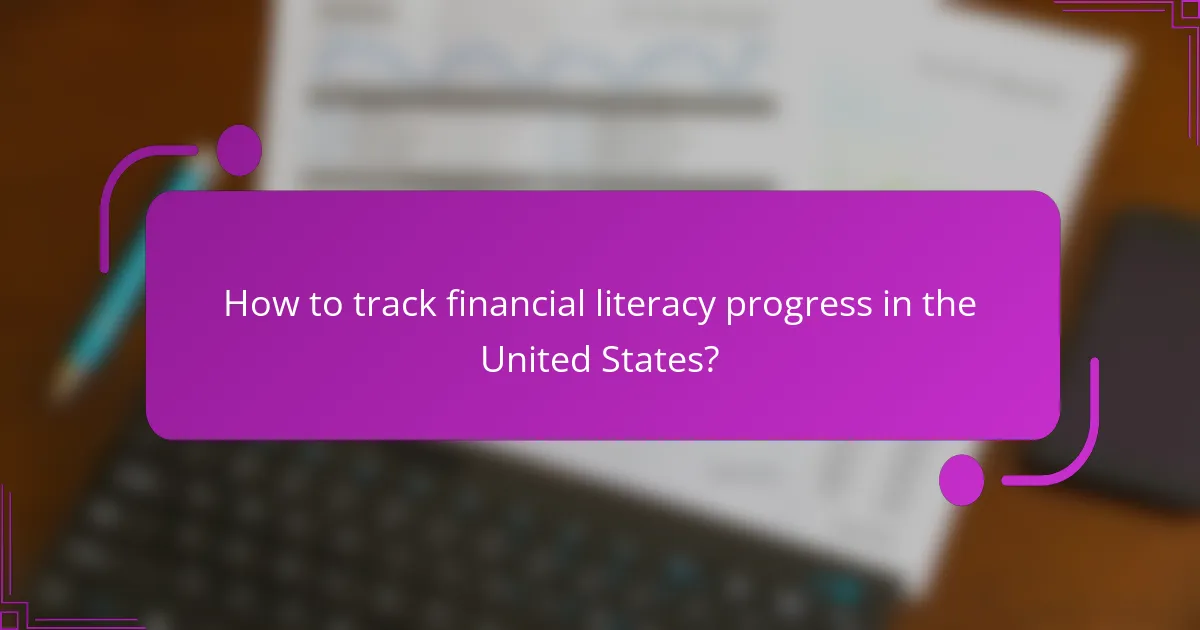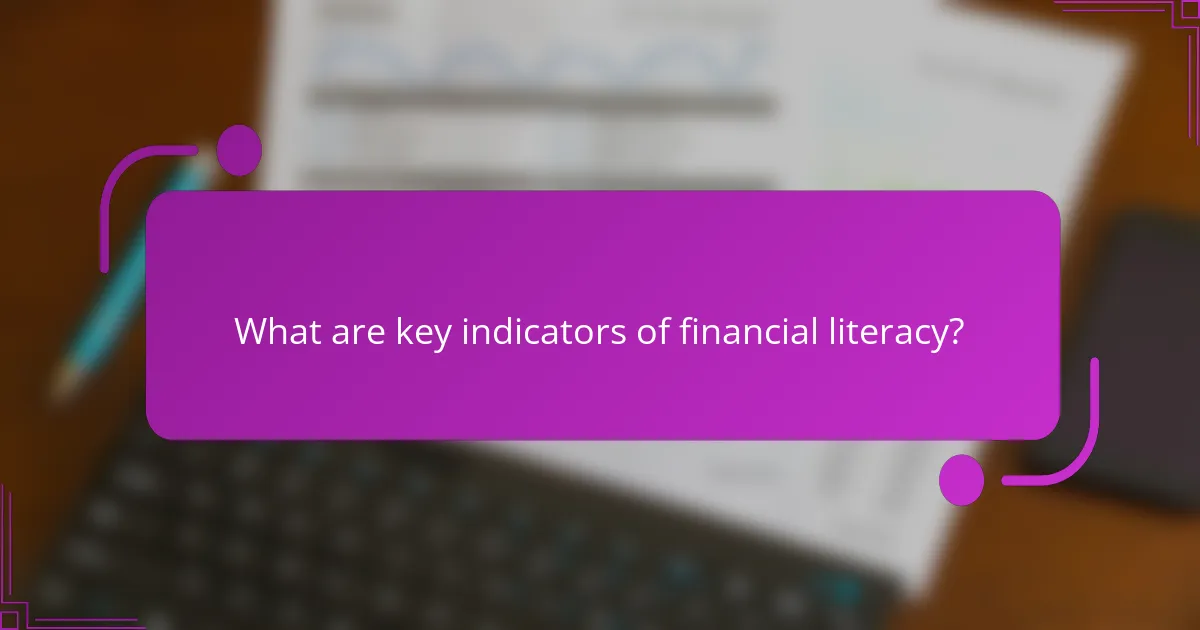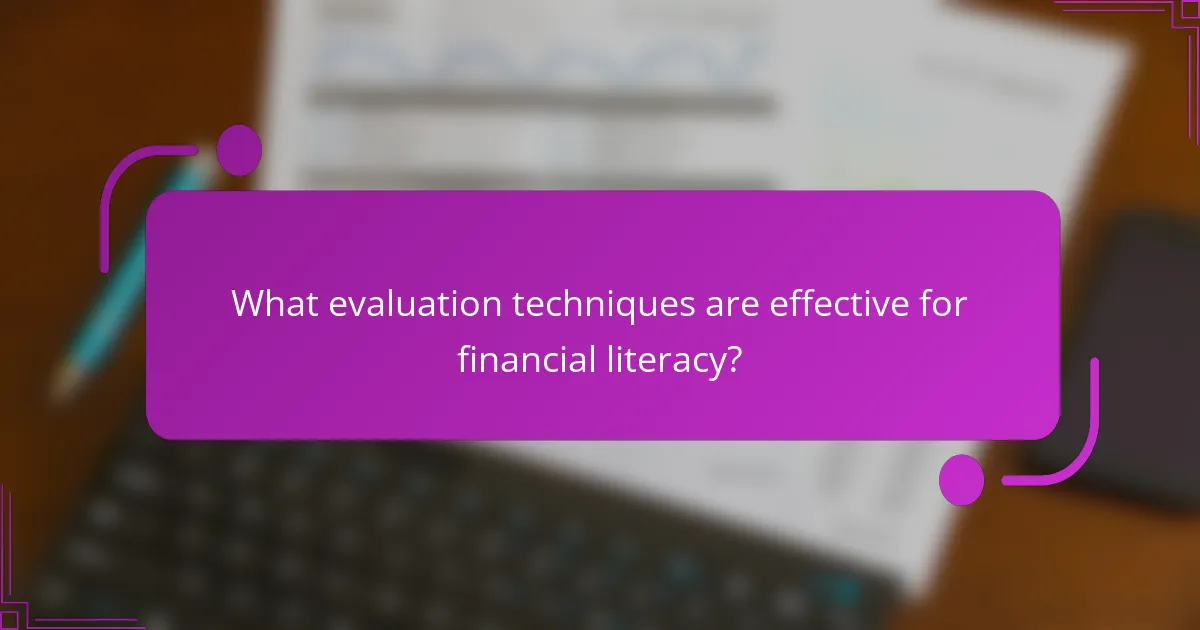Financial literacy metrics play a crucial role in assessing individuals’ knowledge, skills, and behaviors related to personal finance. By utilizing various evaluation techniques such as surveys and longitudinal studies, key indicators like budgeting skills and savings rates can be effectively tracked. These insights not only highlight progress but also identify areas for improvement, ensuring individuals are equipped to make informed financial decisions.

How to track financial literacy progress in the United States?
Tracking financial literacy progress in the United States involves assessing knowledge, skills, and behaviors related to personal finance. This can be achieved through various methods, including surveys, program evaluations, and behavioral monitoring.
Utilizing surveys and assessments
Surveys and assessments are essential tools for measuring financial literacy. They can help identify knowledge gaps and areas for improvement among different demographics. Commonly used surveys include the National Financial Capability Study, which provides insights into financial behaviors and attitudes across the country.
When designing surveys, consider using a mix of multiple-choice questions and open-ended responses to capture a comprehensive view of financial literacy. Aim for a representative sample to ensure the results reflect the broader population.
Implementing financial literacy programs
Financial literacy programs are structured initiatives aimed at educating individuals about managing their finances. These programs can be offered in schools, community centers, or through online platforms. Effective programs often include interactive components, such as workshops or simulations, to engage participants actively.
To evaluate the success of these programs, track participant progress through pre- and post-program assessments. This will help determine the effectiveness of the curriculum and identify areas for enhancement.
Monitoring changes in financial behaviors
Monitoring changes in financial behaviors is crucial for understanding the impact of financial literacy initiatives. This can include tracking behaviors such as budgeting, saving, and investing over time. Regular check-ins or follow-up surveys can provide valuable data on how individuals apply their financial knowledge in real-life situations.
Consider establishing benchmarks for specific behaviors, such as a target savings rate or debt reduction goals, to measure progress effectively. This approach can help motivate individuals to adopt better financial practices.
Leveraging technology for tracking
Technology plays a significant role in tracking financial literacy progress. Mobile apps and online platforms can facilitate self-assessments, budgeting, and tracking spending habits. Many of these tools offer features that allow users to set financial goals and receive feedback on their progress.
Utilizing technology not only makes tracking more accessible but also allows for real-time data collection. Ensure that any tools used are user-friendly and provide clear insights into financial habits and improvements.
Engaging community organizations
Community organizations can be powerful allies in promoting financial literacy. Partnering with local nonprofits, schools, and businesses can enhance outreach efforts and provide additional resources for education. These organizations often have established trust within the community, making them effective in delivering financial literacy programs.
To maximize impact, collaborate on events or workshops that address specific financial literacy needs within the community. This can help tailor programs to local demographics and ensure they are relevant and effective.

What are key indicators of financial literacy?
Key indicators of financial literacy include budgeting skills, savings rates, credit knowledge, and investment awareness. These metrics help assess an individual’s ability to manage finances effectively and make informed financial decisions.
Understanding budgeting skills
Budgeting skills are essential for tracking income and expenses, allowing individuals to allocate funds wisely. A practical approach is to create a monthly budget that categorizes spending into essentials, savings, and discretionary expenses.
To improve budgeting skills, consider using apps or spreadsheets that help visualize financial flows. Aim to keep essential expenses below 50% of your income, savings around 20%, and discretionary spending within 30% for a balanced budget.
Evaluating savings rates
Savings rates indicate the percentage of income set aside for future needs. A healthy savings rate typically ranges from 15% to 20% of gross income, depending on individual goals and financial situations.
To evaluate your savings rate, track your monthly income and calculate how much you save each month. Avoid common pitfalls, such as underestimating expenses or failing to adjust savings goals as income changes.
Assessing credit knowledge
Credit knowledge encompasses understanding credit scores, reports, and the impact of borrowing. Familiarity with these concepts is crucial for making informed decisions about loans and credit cards.
To assess credit knowledge, individuals should know their credit score range and factors affecting it, such as payment history and credit utilization. Regularly reviewing credit reports can help identify errors and improve overall credit health.
Measuring investment awareness
Investment awareness involves understanding different asset classes, risk tolerance, and market dynamics. A well-rounded investor should be familiar with stocks, bonds, mutual funds, and real estate.
To enhance investment awareness, consider starting with basic investment education resources and gradually exploring more complex topics. Setting clear investment goals and regularly reviewing portfolio performance can help maintain focus and adapt strategies as needed.

What evaluation techniques are effective for financial literacy?
Effective evaluation techniques for financial literacy include assessments that measure knowledge before and after programs, longitudinal studies tracking changes over time, and qualitative insights from focus groups and interviews. These methods provide a comprehensive view of financial literacy progress and areas needing improvement.
Pre- and post-program assessments
Pre- and post-program assessments are crucial for evaluating the effectiveness of financial literacy initiatives. These assessments typically involve standardized tests or surveys that gauge participants’ knowledge and skills before and after the program.
To implement this technique, design a clear set of questions that cover key financial concepts such as budgeting, saving, and investing. A common approach is to use a scoring system to quantify improvements, allowing for easy comparison of results.
Longitudinal studies
Longitudinal studies track financial literacy over an extended period, providing insights into how knowledge and behaviors evolve. This method involves repeated observations of the same individuals or groups, which helps identify trends and long-term impacts of financial education.
When conducting a longitudinal study, consider factors such as participant retention and the frequency of data collection. For example, assessing participants annually can reveal how financial behaviors change as individuals face different life stages, such as starting a job or buying a home.
Focus groups and interviews
Focus groups and interviews offer qualitative insights into participants’ experiences and perceptions of financial literacy programs. These discussions can uncover barriers to understanding and applying financial concepts, providing valuable feedback for program improvement.
To effectively use this technique, prepare open-ended questions that encourage participants to share their thoughts. Aim for a diverse group to capture a range of perspectives, and consider conducting sessions in various languages if your audience is multilingual. This approach can help tailor programs to better meet the needs of different demographics.

How to choose the right financial literacy metrics?
Selecting the right financial literacy metrics involves identifying indicators that effectively measure progress towards specific educational goals. These metrics should reflect the knowledge, skills, and behaviors that are essential for financial competence.
Aligning metrics with program goals
To ensure that financial literacy metrics are effective, they must align closely with the overarching goals of the program. For instance, if the goal is to improve budgeting skills, metrics should focus on participants’ ability to create and adhere to a budget.
Consider using specific indicators such as the percentage of participants who can accurately track their expenses or the average amount saved over a defined period. This alignment helps in assessing whether the program is meeting its intended outcomes.
Incorporating stakeholder feedback
Engaging stakeholders in the evaluation process is crucial for refining financial literacy metrics. Feedback from participants, educators, and community partners can provide insights into which metrics are most relevant and useful.
For example, conducting surveys or focus groups can help identify gaps in knowledge and areas where participants feel they need more support. This information can guide the selection of metrics that truly reflect the needs of the community.
Using standardized measurement tools
Standardized measurement tools can enhance the reliability and comparability of financial literacy metrics. Utilizing established assessments, such as the National Financial Capability Study, can provide a benchmark for evaluating progress.
These tools often include validated questions that assess various aspects of financial literacy, such as understanding interest rates and credit scores. Implementing these standardized tools can help ensure that the metrics used are recognized and respected within the field.

